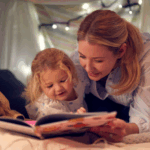
The Building Blocks of Reading: Why phonics is only part of the story
How do children learn to read?
How children learn to read has fascinated people for generations. The truth is, there’s no single formula, Research has not reached any definitive conclusions. All we know is that every child’s journey into literacy is slightly or vastly different, shaped by their experiences, environment, and developing skills. What we do know is that nursery settings play a crucial role in giving children the best possible start, by nurturing the skills that underpin reading.
In order to read, children require a strong foundation in listening and speaking as these are the building blocks of literacy. Activities such as singing nursery rhymes, songs, listening and identifying sounds in the environment, and having rich interactions with adults all help children tune into the rhythms and sounds of language. When children learn to notice sounds, words, and their meaning in everyday things around them, they are better prepared to connect these to written symbols later on.
Talking with children is one of the simplest and yet impressive ways to support their language development. Everyday conversations, whether about what they see on a walk, how they are feeling, or what they had for breakfast, helps children practise expressing themselves, offers an opportunity to hear language modelled, and generally expands their vocabulary. When practitioners take time to listen and respond, it shows children that their words matter, instilling confidence and encouraging curiosity. Language rich exchanges throughout the day strengthen the foundations for reading and a desire to communicate.
Reading to children is also a powerful tool to encourage the development of reading skills. Hearing adults read aloud exposes children to new vocabulary, sentence structures, and ideas beyond what they might encounter in daily conversation. It also models the habit of reading, how a book is held, the turning of pages, the flow of the story, and the excitement of predicting what might happen next. Shared reading helps foster a love of words and children who see reading as an enjoyable, comfortable experience are more motivated to practise reading themselves.
Children require opportunities to play with language, explore stories, practise the sounds and rhythms of words, and develop their speaking and listening skills in a balanced, holistic approach. Nurseries that combine these elements create an environment where literacy feels natural and joyful, rather than forced.
Ultimately, while nobody can pinpoint the exact process by which a child learns to read, we can be sure that nurturing curiosity, instilling confidence, and a love of language in the early years sets children on a path to becoming lifelong readers.
Looking for more support with literacy in early years?
See our https://ndna.org.uk/product/quality-interactions-with-babies-live-virtual-classroom-24/
- Communication
Similar Articles
Top tips: New year new energy - supporting your team

Early years activity: Cosy calm den


